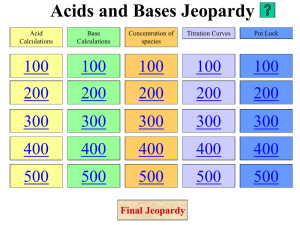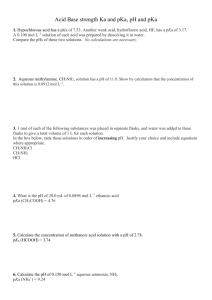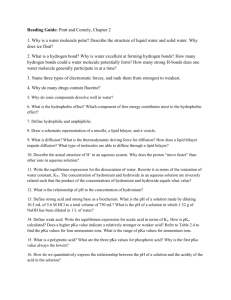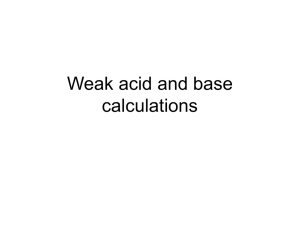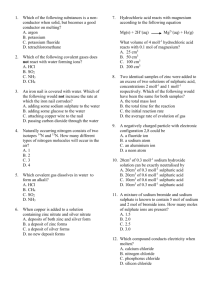Aqueous Chemistry
advertisement
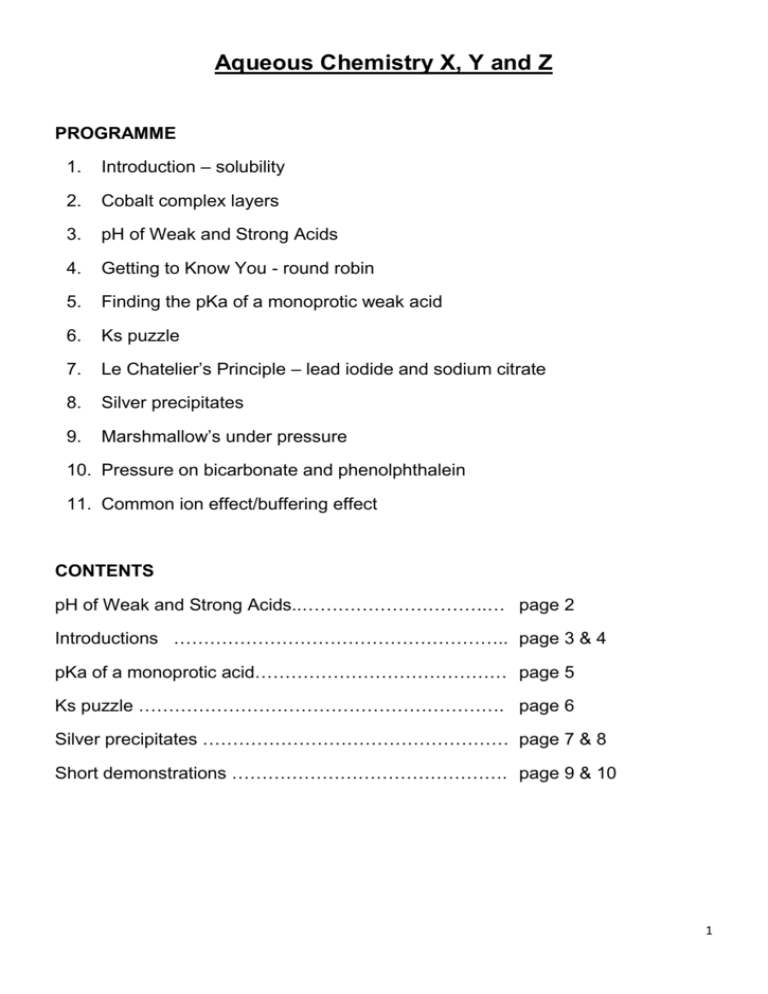
Aqueous Chemistry X, Y and Z PROGRAMME 1. Introduction – solubility 2. Cobalt complex layers 3. pH of Weak and Strong Acids 4. Getting to Know You - round robin 5. Finding the pKa of a monoprotic weak acid 6. Ks puzzle 7. Le Chatelier’s Principle – lead iodide and sodium citrate 8. Silver precipitates 9. Marshmallow’s under pressure 10. Pressure on bicarbonate and phenolphthalein 11. Common ion effect/buffering effect CONTENTS pH of Weak and Strong Acids..………………………….… page 2 Introductions ……………………………………………….. page 3 & 4 pKa of a monoprotic acid…………………………………… page 5 Ks puzzle ……………………………………………………. page 6 Silver precipitates …………………………………………… page 7 & 8 Short demonstrations ………………………………………. page 9 & 10 1 Weak and Strong Acids (Determining pH in the low numbers) Normally we show this by: ► ► ► ► The problem is that changes in pH are difficult to detect if we use two indicators separately. USING INDICATORS TO FIND LOW PH VALUES IN STRONG AND WEAK ACIDS: Methyl orange and methyl violet are used in the experiment to show pH differences between HCl and ethanoic acid of equal concentration and then the effect of dilution on HCl and ethanoic acid. pH Methyl orange Methyl violet 0 pink 1 pink 2 pink 3 orange 4 yellow 5 yellow yellow aqua royal blue purple purple purple Test 1 molL-1 hydrochloric acid and 1 molL-1 ethanoic acid. Students can do serial dilution of both acids and add the varying acids to them. Add to both indicators and record the estimated value. Concentration pH HCl pH ethanoic acid 1 molL-1 0.1molL-1 0.01 molL-1 0.001 molL-1 0.0001 molL-1 0.00001 mol L-1 2 Introductions GETTING TO KNOW YOU – ROUND ROBIN 1. Turn into groups of 4. 2. Person with the most blue on starts 3. Read top question. 4. Person to the left answers and around the circle. 5. Pass the cards to the person on the left 6. The holder of the cards reads the second question, every one answers around the circle and then the cards are passed to the next person on the left and so on. 7. You have 2 minutes to complete the questions. Where are you teaching? What school are you currently teaching at? What is the longest time you have been at one school? What pets do you have? What position do you hold there? How many years have you been teaching? What is the last film you saw in a theatre? What has been your best holiday? 3 PLACEMAT ACTIVITY Aim is to find a consensus Write in your area of the placemat the experiments you do in the Aqueous Chemistry topic. (2 minutes) Next put your favourite experiment in the middle and describe it briefly and say why you like it. Start with the person who has the next birthday. Continue around to the left. Second round add another experiment until there is a maximum of 5 then you may argue for and against until consensus is reached on the group’s favourite experiments. END PRODUCT – YOUR GROUP’S FIVE FAVOURITE EXPERIMENTS. Next step – DISTRIBUTE INFORMATION – GIVE ONE GET ONE - DO THE STROLL PLACEMAT 4 Practical Task - Find the pKa of our acid Objective: Your task is to find the pKa of the monoprotic weak acid you are provided with. Equipment: pH meter, graduated 1ml, 5 ml pipette and 20ml pipette, beakers, flask, three indicators, Solutions: solution of monoprotic weak acid; solution of a strong base (single OH-) unknown concentration; methyl orange pKa = 3.7, methyl red pKa = 5.1, phenolphthalein pKa = 9.0. HINT: Think titration curves (If you complete within 5 minutes what changes would you make to find pKa of a weak base) Our Plan/Method: A possible way to do this. Note: we are working with an unknown concentration solution of a weak monoprotic acid. Take an aliquot of the weak acid, add a few drops of phenolphthalein and titrate to a pink end point with the unknown concentration strong base, possibly NaOH or KOH. Note the volume of base added.(repeat if you wish) Take a further identical volume of the weak acid, and add to this half the measured volume of base added in the first titration. This acid solution should now be half ‘neutralised’. At this stage in a titration pH = pKa Therefor simply measure the pH of this solution with a pH meter and you will have found an accurate (depending on your pH meter) pKa of the weak acid, 5 Ks Puzzle Task: You are given a mixture of calcium, sodium, bromide, magnesium, sulfate, carbonate, chloride. One of the combinations of these ions is commercially valuable and quite profitable. SALT CaSO4 NaCl CaCO3 MgCl2 KBr other % in a solution 0.012% 2.79% 0.01% 0.36% trace trace Ks 9.1x10-6 0.36 2.8x 10-6 0.73 N/A N/A Using the above information decide which combination is commercially valuable. Draw up an outline of: a) how you would separate it from the other salts. b) how you would purify it. Answer: See: Chemical Processes in New Zealand by Packer et al Published by NZIC Second edition 1998 Volume 1 Section I – H The Salt Recovery Process The story of salt harvesting from the sea, at Lake Grassmere 6 Silver Precipitates This is a series of reactions involving solubility, precipitates and formation of complex ions. Record your observations and then explain what has happened. Write equations. Finally use numbers to explain what has happened. Method: 1. In a clean boiling tube, place 8 drops of 0.1molL-1 AgNO3. Add 8 drops of 0.1molL-1 KCl solution. Observations: 2. Now add 15 drops 2 molL-1ammonia solution. Observations: 3. Now add 3 drops 0.1 molL-1, KBr solution. Observations: 4. Now add 6 drops 0.1 molL-1 Na2S2O3 solution. Observations: 5. Now add 3 drops 0.1 molL-1 KI solution. Observations: 6. Now add 8 drops 0.1molL-1 Na2S. Observations 7 What are the Reactions Involved? Steps 1 and 2 are a precipitation reaction followed by the dissolution of the precipitate to form a soluble complex ion. Complete and balance the following equations for these two processes. 1. Ag+(aq) 2. AgCl (S) + + Cl- (aq) → NH3(aq) → Similar equations describe steps 3-6. Number 4 has been done for you- can you complete the others? The data at the bottom of the page may help. 3. 4. AgBr (S) + 2S2O32- (aq) → [Ag(S2O32-)]3- (aq) + Br-(aq) 5. 6. Solubility product Ks for silver compounds at 25○C AgX(s) → Compound AgCl AgBr AgI Ag2S Ag+ + X- Ks 2 x10-10 8 x10-13 8 x10-17 6 x10-51 Formation Constant Kf for complex ions in water at 25○C AgX(s) → Compound [Ag(NH3)2]+ [Ag(S2O 3)2]3- Ag+ + X- Ks 1 x107 1 x1013 8 SHORT DEMONSTRATIONS Cobalt complex layers: 1. Pour a layer of conc HCl into the bottom of a boiling tube. 2. Fill the boiling tube almost to the top with water. Do NOT mix the layers. 3. Fold a cone with a filter paper and make a compass point hole in the bottom of the cone. 4. The bottom of the cone should just touch the top of the water. 5. Pour solid cobalt nitrate into the cone. 6. Allow to stand. 7. If it works there should be three coloured layers. Le Chatelier’s Principle - Lead iodide and sodium citrate 1. Add lead nitrate and potassium iodide. 2. Add sodium citrate until the precipitate disappears 3. Add dilute HNO3 until precipitate reappears 4. Repeat eventually precipitate remains. Pressure and Marshmallows: Put a marshmallow in a flask connected to an aspirator or vacuum pump. Turn on Now you can describe Boyle’s Law. Pressure and bicarbonate and Phenolphthalein Make a saturated solution of sodium hydrogen carbonate. Add about 130ml to a flask connected to an aspirator or vacuum pump (you may want to put in a water trap). Add phenolphthalein. If it is pink add HCl slowly until the pink disappears. 9 Turn on the aspirator. Observe. (HCO3-(aq) ⇌ OH-(aq) + CO2(g)) Common Ion Effect/Buffering Effect Both of these experiments use a buffer of 2 molL-1 ethanoic acid and 10g of sodium ethanoate. Magnesium: 1. Take two 250 ml conical flasks. 2. Quarter fill 2molL-1 ethanoic acid to one. 3. Quarter fill the other flask but add 15g of sodium ethanoate. 4. Add about 3g of magnesium turnings. 5. Balloons over each secure balloons with tape or twist tie. Practise putting the balloons on Use wide mouth balloons Remember both balloons reach the same size. Calcium Carbonate: Works better and gives more definite results. Two large measuring cylinders add 8g of precipitated/powdered calcium carbonate. Add some detergent to both. Solution A – 2molL-1 ethanoic acid Solution B – 2 molL-1ethanoic acid and a heaped teaspoon of sodium ethanoate (10g) Add 100ml of the solution to the measuring cylinders. Note the height of foam. 10 11

